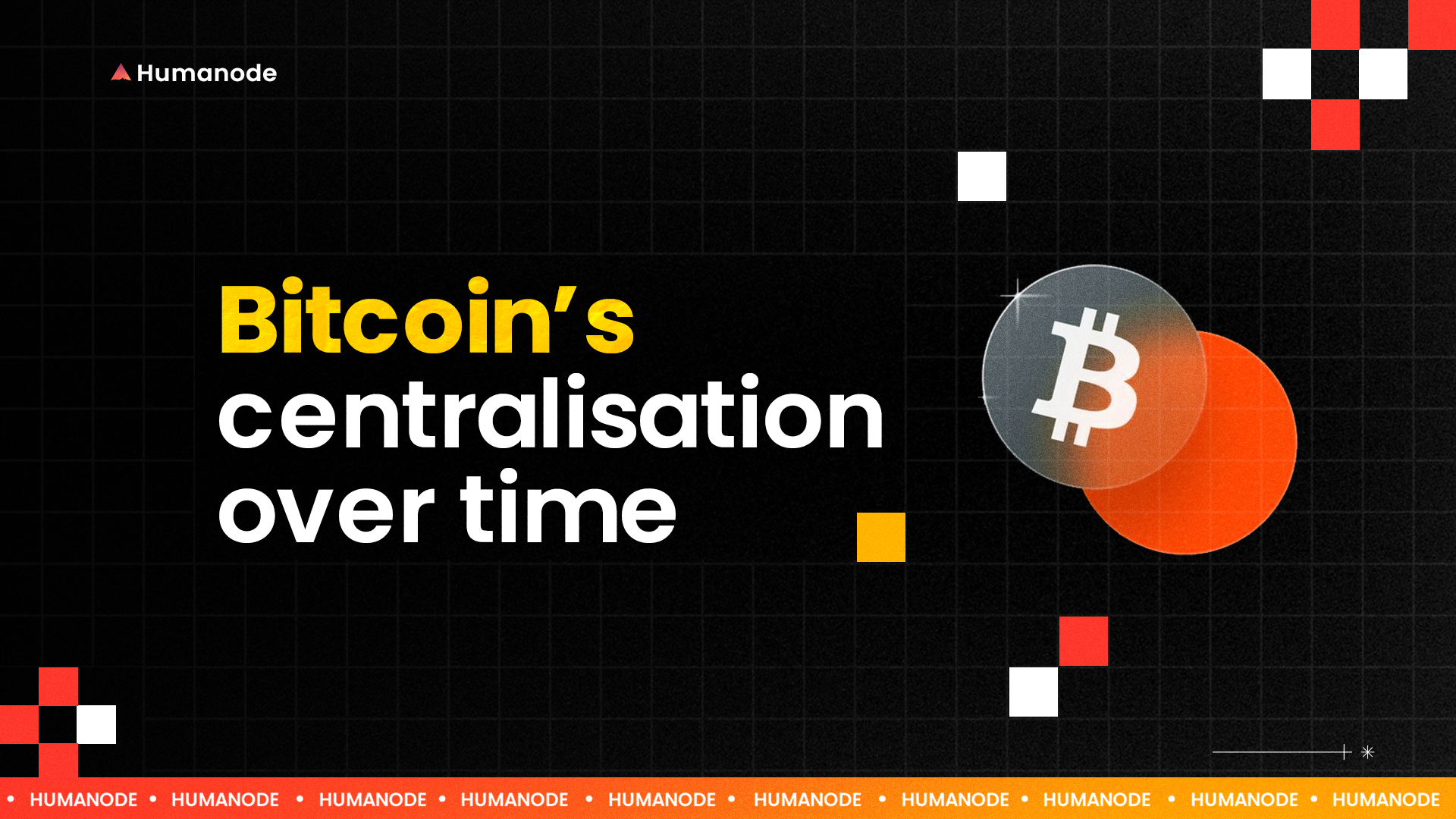Bitcoin’s Hidden Cartels: An Investigation into Mining Centralization

“Who controls Bitcoin?”
It’s a question that won’t die. Early Bitcoin was all about breaking free from banks, bosses, and middlemen. But after more than a decade, power keeps collecting in new corners. It’s moving into the hands of the same big players.
And no, it isn’t just a technical issue; it’s about the principle of control. Back in 2017, Humanode’s co-founder Dato found himself thinking about this. No matter what tech you build, if power gets concentrated, the end result is centralized control in everything but name. On the flip side, if you could guarantee that governance itself stays distributed, even centralized systems could end up more democratic than most blockchains.
That’s where Humanode’s core idea came from: what if you could build a system where every person gets an equal say, no matter their resources or connections? One human, one node. Decentralization, not as a side effect, but as the core.
This article looks back at how, in practice, Bitcoin has drifted away from its original decentralized ideals, especially in terms of mining, and explores power, cartelization, and the control of Bitcoin going into the hands of big players over time.
The Early Days (2009 to 2011)
When Bitcoin first appeared, anyone with a simple computer could mine. People like Hal Finney mined blocks on their laptops. The network was tiny. In 2009, the hashrate was so low it was measured in megahashes per second (MH/s). Everyone mined solo.
Then, in 2010, someone decided to make GPU mining a thing. It was faster than CPU mining, but still something hobbyists could do at home. By 2011, the network reached around 10 terahashes per second (TH/s), with thousands of solo miners.
Fun fact: In 2010, nobody had more than 5% of the hashrate. That was real decentralization.
The Rise of Mining Pools (2011 to 2014)
Mining pools started showing up in 2010. The first was Slush Pool. These pools let miners gather up to create more processing and share rewards. It helped small miners get paid more regularly.
But things changed fast. By 2013, a pool called DeepBit controlled about 30% of the hashrate. That raised some eyebrows among the enthusiasts and the community. Then came ASICs, super-powerful mining machines that beat GPUs by a mile. Bitmain (a hardware manufacturer) made many of these. But they were expensive, which means only those with many can get hold of them, and as a result, solo miners started getting pushed out.
The big moment came in 2014. A pool named GHash.io briefly controlled 51% of the network’s hashrate. That’s dangerous. It meant they could mess with transactions or block them or whatever they wanted to do with them. The community freaked out, and GHash.io promised to reduce its share to 39.99%. But it proved something important: mining could be captured by a single player. It was a serious threat as someone could easily control 51% of the Bitcoin mining network, still you won’t find many people talking about this to date. Why? There could be many reasons. Maybe people believe that with time and the growth of the network, it isn’t possible to carry out such an attack. Or the people with control don’t want it to be discussed. Anyhow, there isn’t any evidence about it.Here’s a hashrate distribution chart from 2011 to 2014
Big Companies Take Over (2015 to 2020)
By the mid-2010s, things got even more centralized. ASICs got stronger. Mining moved into giant warehouses. Pools from China started to dominate.
In 2016, AntPool, F2Pool, and BTC.com, backed by Bitmain, controlled more than 60% of the global hashrate. Cheap hydro power in places like Sichuan helped them grow fast. By 2019, between 65 and 75% of mining was happening in China.
But how was it a concern? In 2017, the New York Agreement exposed how much power these companies had. They tried to push a protocol change (SegWit2x) to increase Bitcoin’s block size. But users fought back, and it failed. Still, it showed that miners could influence how Bitcoin works.
By 2018, the Nakamoto Coefficient, meaning how many entities it takes to control 51% of the hashrate, dropped to just 3. That’s centralized control of a decentralized technology.
The China Ban and U.S. Takeover (2021 to 2025)
In 2021, China banned crypto mining. This caused a global shift. A lot of mining moved to the U.S. States like Texas and Wyoming welcomed miners with cheap energy and friendly laws.
By 2025, the U.S. made up 75.4% of the global hashrate, around 600 EH/s out of 796 EH/s.
Together, the top 6 pools control more than 95% of all mining. Foundry USA, AntPool, and ViaBTC alone have 57%. The Nakamoto Coefficient? Still just 3.
Mining Pools Acting Like Cartels
Big pools have already shown they can censor transactions.
- In 2020, BlockSeer filtered out transactions linked to OFAC-sanctioned addresses.
- In 2021, Marathon Digital tested “clean” Bitcoin blocks, avoiding certain transactions.
- In 2023, F2Pool also blocked some transactions, then backtracked. Sources: Cointelegraph, CoinDesk, Bitcoin Magazine
These actions show that pools can influence what goes into blocks. That breaks Bitcoin’s promise of being censorship-resistant.
A 2024 study also talked about “selfish mining”, a way for pools to trick the system and earn more. No one’s caught doing it yet, but the risk is real.
Wealth Is Also Centralized
Mining is not the only thing controlled by a few. So is the money itself.
- As of 2024, just 2% of Bitcoin addresses hold 85% of all BTC.
- MicroStrategy alone has 601,550 BTC.
- ETFs and funds control about 31% of all known BTC.
- And you all already know about the centralized exchanges
These rich holders could influence how mining works by funding certain pools or setting terms.
The Big Risks
Mining centralization brings serious risks:
- 51% Attacks: One cartel could double-spend or block transactions
- Government Pressure: U.S.-based miners can be forced to censor due to laws like OFAC
- Control Over Upgrades: Pools tried this before in 2017 (SegWit2x)
In 2025, just 10 mining pools control 92% of block production.
Apart from mining, other coefficients that could be used to measure the centralization of Bitcoin also show serious concerns. Here’s a nakamoto coefficient chart based on different factors that influence centralization.
Summing Up
After more than a decade, the dream of a truly decentralized Bitcoin has almost vanished. People choose to chase the hype over the real idea. And behind the scenes, as per the evidence, power players keep taking control into their hands one by one. Be it the mining pools, the governance, or the currency itself.
Even the most elegant technology can’t outrun the basic truth: if control concentrates, the result is centralization.
That's why, for those, like Humanode, who really believe in a truly decentralized system, the lesson is very clear. It isn't about the infrastructure or hardware, but rather about making sure no one is able to quietly tip the scales. It's about recognizing the basic truth: if control concentrates, the result is centralization. It's about designing a system where everyone gets an equal seat at the table by default, not just by accident.
Bitcoin's journey to becoming centralized and in the hands of a few is a reminder that decentralization isn't guaranteed; it has to be built in, protected, and re-examined constantly. Otherwise, even the boldest experiments can become like the old systems they try to replace,the as happened in case of Bitcoin.
Sources:
- https://bitcoinmagazine.com/technical/bitcoin-decentralization-and-where-to-find-it
- https://digiconomist.net/cryptocurrency-decentralization/
- https://www.frontiersin.org/journals/blockchain/articles/10.3389/fbloc.2021.730122/full
- https://www.sciencedirect.com/science/article/pii/S2405959524000079
- https://hashrateindex.com/
- https://cryptopotato.com/growing-complexity-in-bitcoin-mining-landscape-amidst-centralization-risks-coin-metrics/
- https://bitbo.io/tools/mining-calculator/
- https://www.statista.com/statistics/1200477/bitcoin-mining-by-country/
- https://b10c.me/blog/015-bitcoin-mining-centralization/

